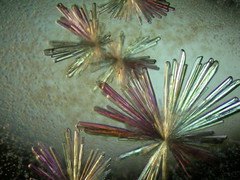The molecules self-assembled to create a semi-conducting film
In a bid to develop a transistor that didn’t need to be created in a “top down” approach” as is the case with silicon-based transistors, researchers at Tel Aviv University (TAU) turned to blood, milk and mucus proteins. The result is protein-based transistors the researchers say could form the basis of a new generation of electronic devices that are both flexible and biodegradable.
When the researchers applied various combinations of blood, milk, and mucus proteins to any base material, the molecules self-assembled to create a semi-conducting film on a nano-scale. Each of the three different kinds of proteins brought something unique to the table, said TAU Ph.D. student Elad Mentovich, and allowed the team to create a complete circuit with electronic and optical capabilities.
The blood protein’s ability to absorb oxygen permitted the doping of semi-conductors with specific chemicals to create particular properties. Milk proteins, which boast impressive strength in difficult environments, were used to form the fibers that are the building blocks of the team’s transistor. While mucosal proteins, with their ability to keep red, green and blue fluorescent dyes separate, were used to create the white light emission necessary for advanced optics.
By taking advantage of the natural abilities of each protein, the researchers were able to control various characteristics of the transistor, including adjusting conductivity, memory storage, and fluorescence, among other things.
The research team, which also includes Ph.D. students Netta Hendler and Bogdan Belgorodsky, supervisor Dr. Shachar Richter and Prof. Michael Gozin, believes their new transistor could play a big role in the transition from a silicon to a carbon era.
Read more . . .
Bookmark this page for “Biodegradable transistors” and check back regularly as these articles update on a very frequent basis. The view is set to “news”. Try clicking on “video” and “2” for more articles.









